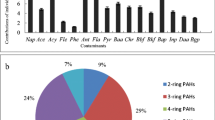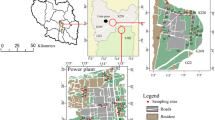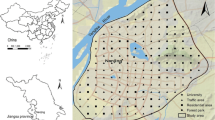Abstract
The ubiquity of polycyclic aromatic hydrocarbons (PAHs) in soils in petroleum refining areas is an important problem affecting human and ecological safety. In this study, 103 topsoil (0–0.50 m) samples were collected from a retired petroleum refinery area in Guangdong province, south China. The PAHs concentrations were determined by ultrasonic extraction and gas chromatography–mass spectrometry detection methods. Twelve PAHs controlled priority listed by the US Environmental Protection Agency (USEPA) were investigated. The results revealed that the concentration of Ʃ12PAHs ranged from 2100 to 5200 µg kg−1, with a mean value of 3741.66 µg kg−1. The site was dominated by high rings PAHs (4-, 5-, and 6-ring), contributing 81.96% to Ʃ12PAHs. The concentrations of 9 kinds of PAHs exceeded the Dutch soil quality standard. Besides, the PAHs were primarily distributed in the storage tank area and with high levels of contamination. The results of hierarchical cluster analysis (HCA) and principal component analysis (PCA) indicated that coal combustion was the source of PAHs in topsoil, followed by petroleum drip** and traffic emissions. The incremental lifetime cancer risk (ILCR) modeling illustrated that soil ingestion was the major pathway of PAH exposure for both adults and children. Notably, the total noncarcinogenic human health risk due to PAHs was within the limit of 1, while the carcinogenic risks alone caused by benzo(a)pyrene via soil ingestion to adults and children were obviously beyond the USEPA limit (1.00E −06). Therefore, PAHs in the petroleum refinery areas have potential carcinogenic hazards to human health, the area should be remediated before reuse.







Similar content being viewed by others
Data availability
All data generated or analyzed during this study are included in this published article (and its supplementary information files).
References
Adelaja, O., Keshavarz, T., & Kyazze, G. (2015). The effect of salinity, redox mediators and temperature on anaerobic biodegradation of petroleum hydrocarbons in microbial fuel cells. Journal of Hazardous Materials, 283, 211–217. https://doi.org/10.1016/j.jhazmat.2014.08.066
Agarwal, T., Khillare, P. S., Shridhar, V., & Ray, S. (2009). Pattern, sources and toxic potential of PAHs in the agricultural soils of Delhi, India. Journal of Hazardous Materials, 163, 1033–1039. https://doi.org/10.1016/j.jhazmat.2008.07.058
Bahrami, S., Moore, F., & Keshavarzi, B. (2019). Evaluation, source apportionment and health risk assessment of heavy metal and polycyclic aromatic hydrocarbons in soil and vegetable of Ahvaz metropolis. Human and Ecological Risk Assessment, 27, 71–100. https://doi.org/10.1080/10807039.2019.1692300
Barbara, M. K., Bozena, S., & Agnieszka, K. P. (2009). Concentrations, sources, and spatial distribution of individual polycyclic aromatic hydrocarbons (PAHs) in agricultural soils in the Eastern part of the EU: Poland as a case study. Science of the Total Environment, 407, 3746–3753. https://doi.org/10.1016/j.scitotenv.2009.01.010
Basavaiah, N., Mohite, R. D., Singare, P. U., Reddy, A. V., Singhal, R. K., & Blaha, U. (2017). Vertical distribution, composition profiles, sources and toxicity assessment of PAH residues in the reclaimed mudflat sediments from the adjacent Thane Creek of Mumbai. Marine Pollution Bulletin, 118, 112–124. https://doi.org/10.1016/j.marpolbul.2017.02.049
Boonyatumanond, R., Wattayakorn, G., & Togo, A. (2006). Distribution and origins of polycyclic aromatic hydrocarbons (PAHs) in riverine, estuarine, and marine sediments in Thailand. Marine Pollution Bulletin, 52, 942–956. https://doi.org/10.1016/j.marpolbul.2005.12.015
Britten, A. J., & Naikwadi, K. P. (2009). New nano stationary phase GC capillary columns for fast analysis of PAH by GC and GC/MS. International Journal of Environmental Analytical Chemistry, 89, 1113–1123. https://doi.org/10.1080/03067310902962510
Bu, Q. W., Zhang, Z. H., Lu, S., & He, F. P. (2009). Vertical distribution and environmental significance of PAHs in soil profiles in Bei**g, China. Environmental Geochemistry and Health, 31, 119–131. https://doi.org/10.1007/s10653-008-9171-z
Cai, C., Li, J., Wu, D., Wang, X., Tang, D. C., Li, X., Sun, J., Zhu, L., Shen, H., Tao, S., & Liu, W. (2017). Spatial distribution, emission source and health risk of parent PAHs and derivatives in surface soils from the Yangtze River Delta, eastern China. Chemosphere, 178, 301–308. https://doi.org/10.1016/j.chemosphere.2017.03.057
Chen, Y., Zhang, F., Gao, Q., & Zhang, J. (2021). Pollution and risk assessment of polycyclic aromatic hydrocarbons (PAHs) in agricultural soil along a highway of Jilin Province, China. Soil and Sediment Contamination: An International Journal, 1–17. https://doi.org/10.1080/15320383.2021.1913572
Cousins, I. T., Gevao, B., & Jones, K. C. (1999). Measuring and modelling the vertical distribution of semi-volatile organic compounds in soils. I: PCB and PAH soil core data. Chemosphere, 39, 2507–2518. https://doi.org/10.1016/s0045-6535(99)00164-2
Dudhagara, D. R., Rajpara, R. K., Bhatt, J. K., Gosai, H. B., Sachaniya, B. K., & Dave, B. P. (2016). Distribution, sources and ecological risk assessment of PAHs in historically contaminated surface sediments at Bhavnagar coast, Gujarat, India. Environmental Pollution, 213, 338–346. https://doi.org/10.1016/j.envpol.2016.02.030
Fraser, M. P., Cass, G. R., & Simoneit, B. R. (1998). Gas-phase and particle-phase organic compounds emitted from motor vehicle traffic in a Los Angeles roadway tunnel. Environmental Science and Technology, 32, 2051–2060. https://doi.org/10.1021/es970916e
Harrison, R. M., Smith, D. J., & Luhana, L. (1996). Source apportionment of atmospheric polycyclic aromatic hydrocarbons collected from an urban location in Birmingham, U.K. Environmental Science & Technology, 30, 825–832. https://doi.org/10.1021/es950252d
Hassanshahian, M., & Boroujeni, N. A. (2016). Enrichment and identification of naphthalene-degrading bacteria from the Persian Gulf. Marine Pollution Bulletin, 107(1), 59–65. https://doi.org/10.1016/j.marpolbul.2016.04.020
Jia, J. P., Bi, C. J., Guo, X., Wang, X. P., Zhou, X. X., & Chen, Z. L. (2017). Characteristics, identification, and potential risk of polycyclic aromatic hydrocarbons in road dusts and agricultural soils from industrial sites in Shanghai, China. Environmental Science and Pollution Research, 24, 605–615. https://doi.org/10.1007/s11356-016-7818-3
Jiang, Y. F., Wang, X. D., Wu, M., & H., Sheng, G.Y., & Fu, J.M. (2011). Contamination, source identification, and risk assessment of polycyclic aromatic hydrocarbons in agricultural soil of Shanghai, China. Environmental Monitoring and Assessment, 183, 139–150. https://doi.org/10.1007/s10661-011-1913-1
Kamal, A., Cincinelli, A., Martellini, T., & Malik, R. N. (2016). Linking mobile source PAHs and biological effects in traffic police officers and drivers in Rawalpindi (Pakistan). Ecotoxicology and Environmental Safety, 127, 135–143. https://doi.org/10.1016/j.ecoenv.2016.01.006
Karaca, G. (2016). Spatial distribution of polycyclic aromatic hydrocarbon (PAH) concentrations in soils from Bursa, Turkey. Archives of Environmental Contamination and Toxicology, 70, 406–417. https://doi.org/10.1007/s00244-015-0248-2
Kavouras, I. G., Koutrakis, P., Tsapakis, M., Lagoudaki, E., Stephanou, E. G., Baer, D. V., & Oyola, P. (2001). Source apportionment of urban particulate aliphatic and polynuclear aromatic hydrocarbons (PAHs) using multivariate methods. Environmental Science & Technology, 35, 2288–2294. https://doi.org/10.1021/es001540z
Keith, L. H. (2015). The source of US EPA’s sixteen PAH priority pollutants. Polycyclic Aromatic Compounds, 35, 147–160. https://doi.org/10.1080/10406638.2014.892886
Larsen, R. K., & Baker, J. E. (2003). Source apportionment of polycyclic aromatic hydrocarbons in the urban atmosphere: A comparison of three methods. Environmental Science and Technology, 37, 1873–1881. https://doi.org/10.1021/es0206184
Lemaire, J., Bues, M., Kabeche, T., Hanna, K., & Simonnot, M. O. (2013). Oxidant selection to treat an aged PAH contaminated soil by in situ chemical oxidation. Journal of Environmental Chemical Engineering, 1, 1261–1268. https://doi.org/10.1016/j.jece.2013.09.018
Li, R. F., Hua, P., Cai, J. L., Wang, X., Zhu, Y., Huang, Z. Y., Li, P. F., Wang, Z. Y., Bai, Y., Hu, B. X., Zhang, J., & Krebs, P. (2019b). A sixteen-year reduction in the concentrations of aquatic PAHs corresponding to source shifts in the Elbe River, Germany. Journal of Cleaner Production, 223, 631–640. https://doi.org/10.1016/j.jclepro.2019.03.159
Li, X., Zheng, R., Bu, Q., Cai, Q. H., Liu, Y. F., Lu, Q., & Cui, J. Z. (2019a). Comparison of PAH content, potential risk in vegetation, and bare soil near Daqing oil well and evaluating the effects of soil properties on PAHs. Environmental Science and Pollution Research, 26, 25071–25083. https://doi.org/10.1007/s11356-019-05720-y
Li, X. F., Zhao, L., & Adam, M. (2016). Biodegradation of marine crude oil pollution using a salt-tolerant bacterial consortium isolated from Bohai Bay. China. Marine Pollution Bulletin, 105(1), 43–50. https://doi.org/10.1016/j.marpolbul.2016.02.073
Liu, X., Bai, Z., Yu, Q., Cao, Y., & Zhou, W. (2017). Polycyclic aromatic hydrocarbons in the soil profiles (0–100 cm) from the industrial district of a large open-pit coal mine, China. RSC Advances, 7, 28029–28037. https://doi.org/10.1039/C7RA02484C
Lu, Q., Wang, S. J., Bai, X. Y., Liu, F., Li, C. J., Deng, Y. H., & Tian, S. Q. (2021). Quantitative assessment of human health risks under different land uses based on soil heavy metal pollution sources. Human and Ecological Risk Assessment: An International Journal, 27, 2. https://doi.org/10.1080/10807039.2019.1710811
Lu, Y. F., & Lu, M. (2015). Remediation of PAH-contaminated soil by the combination of tall fescue, arbuscular mycorrhizal fungus and epigeic earthworms. Journal of Hazardous Materials, 285, 535–541. https://doi.org/10.1016/j.jhazmat.2014.07.021
Mahugija, J. A. M. (2015). Levels and profiles of polycyclic aromatic hydrocarbons and polychlorinated biphenyls in soil at an industrial area in Dar Es Salaam, Tanzania. BEST: International Journal of Humanities. Arts, Medicine and Sciences, 3, 1–8.
Mai, B. X., Fu, H. M., Sheng, G. Y., Kang, Y. H., Lin, Z., Zhang, G., Min, Y. S., & Zeng, E. Y. (2002). Chlorinated and polycyclic aromatic hydrocarbons in riverine and estuarine sediments from Pearl River Delta, China. Environmental Pollution, 117, 457–474. https://doi.org/10.1016/S0269-7491(01)00193-2
Maliszewska-Kordybach, B. (1996). Polycyclic aromatic hydrocarbons in agricultural soils in Poland: Preliminary proposals for criteria to evaluate the level of soil contamination. Applied Geochemistry, 11, 121–127. https://doi.org/10.1016/0883-2927(95)00076-3
Menzie, C. A., & Potocki, B. B. (1992). Ambient concentrations and exposure to carcinogenic PAHs in the environment. Environmental Science and Technology, 26, 1278–1284.
MEPRC (Ministry of Ecology and Environment of the People’s Republic of China). (2014). HJ25.3–2014 technical guidelines for risk assessment of contaminated sites. Bei**g: China Environmental Science Press.
Montuori, P., Aurino, S., Garzonio, F., Sarnacchiaro, P., Nardone, A., & Triassi, M. (2016). Distribution, sources and ecological risk assessment of polycyclic aromatic hydrocarbons in water and sediments from Tiber River and estuary, Italy. Science of the Total Environment, 566–567, 1254–1267. https://doi.org/10.1016/j.scitotenv.2016.05.183
Moubasher, H. A., Hegazy, A. K., Mohamed, N. H., Moustafa, Y. M., Kabiel, H. F., & Hamad, A. A. (2015). Phytoremediation of soils polluted with crude petroleum oil using Bassia scoparia and its associated rhizosphere microorganisms. International Biodeterioration & Biodegradation, 98, 113–120. https://doi.org/10.1016/j.ibiod.2014.11.019
Nasrin, R. K., Peter, A. S., & Thomas, M. H. (1995). PAH source fingerprints for coke ovens, diesel and gasoline engines, highway tunnels, and wood combustion emissions. Atmospheric Environment, 29, 533–542. https://doi.org/10.1016/1352-2310(94)00275-P
Nisbet, I. C., & Lagoy, P. K. (1992). Toxic equivalency factors (TEFs) for polycyclic aromatic hydrocarbons (PAHs). Regulatory Toxicology and Pharmacology, 16, 290–300. https://doi.org/10.1016/0273-2300(92)90009-X
Peng, C., Chen, W., Liao, X., Wang, M., Ouyang, Z. Y., Jiao, W., & Bai, Y. (2011). Polycyclic aromatic hydrocarbons in urban soils of Bei**g: Status, sources, distribution and potential risk. Environmental Pollution, 159, 802–808. https://doi.org/10.1016/j.envpol.2010.11.003
Peng, C., Wang, M., & Chen, W. (2016). Spatial analysis of PAHs in soils along an urban-suburban-rural gradient: Scale effect, distribution patterns, diffusion and influencing factors. Scientific Reports, 6, 37185. https://doi.org/10.1038/srep37185
Rachwal, M., Magieral, T., & Wawer, M. (2015). Coke industry and steel metallurgy as the source of soil contamination by technogenic magnetic particles, heavy metals and polycyclic aromatic hydrocarbons. Chemosphere, 138, 863–873. https://doi.org/10.1016/j.chemosphere.2014.11.077
Ravindra, K., Sokhi, R., & Grieken, R. V. (2008). Atmospheric polycyclic aromatic hydrocarbons: Source attribution, emission factors and regulation. Atmospheric Environment, 42, 2895–2921. https://doi.org/10.1016/j.atmosenv.2007.12.010
Rasmussen, P. E., Subramanian, K. S., & Jessiman, B. J. (2001). A multielement profile of house dust in relation to exterior dust and soils in the city of Ottawa, Canada. Science of the Total Environment, 267, 125–140. https://doi.org/10.1016/S0048-9697(00)00775-0
SAC (Standardization Administration of China). (2019). GB 4284–2018 control standards of pollutants in sludge for agricultural use.
Simcik, M. F., Eisenreich, S. J., & Lioy, P. J. (1999). Source apportionment and source/sink relationships of PAHs in the coastal atmosphere of Chicago and Lake Michigan. Atmospheric Environment, 33, 5071–5079. https://doi.org/10.1016/S1352-2310(99)00233-2
Song, W., Li, J., Zhang, W., Hu, X., & Wang, L. (2012). An experimental study on the remediation of phenanthrene in soil using ultrasound and soil washing. Environmental Earth Sciences, 66(5), 1487–1496. https://doi.org/10.1007/s12665-011-1388-y
Song, Y., Fang, G. D., Zhu, C. Y., Zhu, F. X., Wu, S., Chen, N., Wu, T. L., Wang, Y. J., Gao, J., & Zhou, D. M. (2018). Zero-valent iron activated persulfate remediation of polycyclic aromatic hydrocarbon-contaminated soils: An in-situ pilot-scale study. Chemical Engineering Journal, 355(1), 65–75. https://doi.org/10.1016/j.cej.2018.08.126
Suman, S., Sinha, A., & Tarafdar, A. (2016). Polycyclic aromatic hydrocarbons (PAHs) concentration levels, pattern, source identification and soil toxicity assessment in urban traffic soil of Dhanbad, India. Science of the Total Environment, 545–546, 353–360. https://doi.org/10.1016/j.scitotenv.2015.12.061
Sun, C. Y., Zhang, J. Q., Ma, Q. Y., Chen, Y. N., & Ju, H. Y. (2017). Polycyclic aromatic hydrocarbons (PAHs) in water and sediment from a river basin: Sediment-water partitioning, source identification and environmental health risk assessment. Environmental Geochemistry and Health, 39, 63–74. https://doi.org/10.1007/s10653-016-9807-3
Tao, S., Cao, H. Y., Liu, W. X., Li, B. G., Cao, J., Xu, F. L., Wang, X. J., Coveney, R. M., Shen, W. R., Qin, B. P., & Sun, R. (2003). Fate modeling of phenanthrene with regional variation in Tian**, China. Environmental Science and Technology, 37, 2453–2459. https://doi.org/10.1021/es021023b
USEPA. (1997). Exposure factors handbook. Office of Research and Development.
USEPA. (1999). Risk assessment guidance for superfund, volume 1, human health evaluation manual (part B, development of risk-based preliminary remediation goals).
USEPA. (2001). Exposure factors handbook edition (Final Report). National Center for Environmental Assessment: Washington, DC.
USEPA. (2015). Toxic and priority pollutants under the Clean Water Act.
Usman, M., Chaudhary, A., Biache, C., Faure, P., & Hanna, K. (2016). Effect of thermal pre-treatment on the availability of PAHs for successive chemical oxidation in contaminated soils. Environmental Science and Pollution Research, 23(2), 1371–1380. https://doi.org/10.1007/s11356-015-5369-7
Wang, C., Zhou, S., Song, J., Tang, J., & Wu, S. (2020). Formation mechanism of soil PAH distribution: High and low urbanization. Geoderma, 367, 114271. https://doi.org/10.1016/j.geoderma.2020.114271
Wang, C. F., Wang, X. P., Gong, P., & Yao, T. D. (2014). Polycyclic aromatic hydrocarbons in surface soil across the Tibetan Plateau: Spatial distribution, source and air-soil exchange. Environmental Pollution, 184, 138–144. https://doi.org/10.1016/j.envpol.2013.08.029
Wang, C. H., Zhou, S. L., Song, J., & Wu, S. H. (2018). Human health risks of polycyclic aromatic hydrocarbons in the urban soils of Nan**g, China. Science of the Total Environment, 612, 750–757. https://doi.org/10.1016/j.scitotenv.2017.08.269
Wang, H. S., Liang, P., Kang, Y., Shao, D. D., Zheng, G. J., Wu, S. C., Wong, C. K., & Wong, M. H. (2010b). Enrichment of polycyclic aromatic hydrocarbons (PAHs) in mariculture sediments of Hong Kong. Environmental Pollution, 158, 3298–3308. https://doi.org/10.1016/j.envpol.2010.07.022
Wang, W. T., Massey, S. S., Xue, M., Zhao, J. Y., Zhang, N., Wang, R., Cao, J., & Tao, S. (2010a). Concentrations, sources and spatial distribution of polycyclic aromatic hydrocarbons in soils from Bei**g, Tian** and surrounding areas, North China. Environment Pollution, 158, 1245–1251. https://doi.org/10.1016/j.envpol.2010.01.021
Whitacre, D. M. (2015). Source characterization of polycyclic aromatic hydrocarbons by using their molecular indices: An overview of possibilities. Reviews of Environmental Contamination and Toxicology, 234, 49–133. https://doi.org/10.1007/978-3-319-10638-0_2
White, P. D., & Marcus, A. H. (1998). The conceptual structure of the integrated exposure uptake bio kinetic model for lead in children. Environmental Health Perspect, 106, 1513–1530. https://doi.org/10.1289/ehp.98106s61513
Wilcke, W. (2000). Polycyclic aromatic hydrocarbons (PAHs) in soil a review. Journal of Plant Nutrition and Soil Science, 163, 229–248. https://doi.org/10.1002/1522-2624(200006)163:33.0.CO;2-6
**ao, Q., Zhou, Y. T., & Lu, S. G. (2015). Assessment of heavy metal pollution and human health risk in urban soils of steel industrial city (Anshan), Liaoning, Northeast China. Ecotoxicology Environment Safety, 120, 377–385. https://doi.org/10.1016/j.ecoenv.2015.06.019
Yan, B., Abrajano, T. A., Bopp, R. F., Benedict, L. A., Chaky, D. A., Perry, J., Song, J., & Keane, D. P. (2006). Combined application of δ13C and molecular ratios in sediment cores for PAH source apportionment in the New York/New Jersey harbor complex. Organic Geochemistry, 37, 674–687. https://doi.org/10.1016/j.orggeochem.2006.01.013
Yunker, M. B., Macdonald, R. W., Vingarzan, R., Mitchell, R. H., Goyette, D., & Sylvestre, S. (2002). PAHs in the Fraser River basin: A critical appraisal of PAH ratios as indicators of PAH source and composition. Organic Geochemistry, 33, 489–551. https://doi.org/10.1016/S0146-6380(02)00002-5
Zhang, J. Q., Qu, C. K., Qi, S. H., Cao, J. J., Zhan, C. L., **ng, X. L., **ao, Y. L., Zheng, J. R., & **ao, W. S. (2015). Polycyclic aromatic hydrocarbons (PAHs) in atmospheric dustfall from the industrial corridor in Hubei Province, Central China. Environmental Geochemistry and Health, 37, 891–903. https://doi.org/10.1007/s10653-014-9647-y
Zheng, H., Qu, C.K., Zhang, J.Q., Talpur, S.A., & Qi, S.H. (2019). Polycyclic aromatic hydrocarbons (PAHs) in agricultural soils from Ningde, China: Levels, sources, and human health risk assessment. Environmental Geochemistry and Health, 41(2). https://doi.org/10.1007/s10653-018-0188-7
Zhou, Q.X., Li, D., Wang, T., & Hu, X. (2020). Leaching of graphene oxide nanosheets in simulated soil and their influences on microbial communities. Journal of Hazardous Materials, 124046. https://doi.org/10.1016/j.jhazmat.2020.124046
Acknowledgements
The authors are grateful to National Key Research and Development Program of China (grant No 2018YFC1800306, 2019YFC1805805) and National Natural Science foundation of China (grant No 91644104) for supporting this research. The authors are also thankful to the Chinese Academy of Sciences and Tian** Normal University for their support of this research. Finally, the authors are also thankful to the anonymous reviewers for their academic comments, which helped to improve the manuscript.
Funding
This research was supported by the National Key Research and Development Program of China (grant No 2018YFC1800306, 2019YFC1805805) and National Natural Science foundation of China (grant No 91644104).
Author information
Authors and Affiliations
Corresponding author
Ethics declarations
Conflict of interest
The authors declare no competing interests.
Additional information
Publisher's Note
Springer Nature remains neutral with regard to jurisdictional claims in published maps and institutional affiliations.
Supplementary Information
Below is the link to the electronic supplementary material.
Rights and permissions
About this article
Cite this article
Ma, W., Hu, J., Li, J. et al. Distribution, source, and health risk assessment of polycyclic aromatic hydrocarbons in the soils from a typical petroleum refinery area in south China. Environ Monit Assess 194, 678 (2022). https://doi.org/10.1007/s10661-022-10281-8
Received:
Accepted:
Published:
DOI: https://doi.org/10.1007/s10661-022-10281-8




